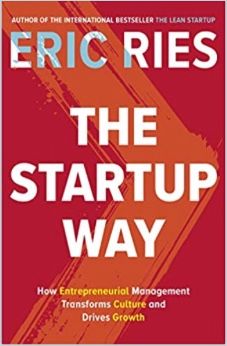Many people working in established organizations struggle with red tape, silo mentality and short-term thinking. What if you could re-instill the spirit of entrepreneurship that got these companies off the ground initially?

Entrepreneurship as a mind-set
When entrepreneur and best-selling author Eric Ries published his first book, The Lean Startup, he started a global movement. Minimum viable products, experimenting, feedback loops and pivoting became buzz words that defined successful entrepreneurialism. With The Startup Way, Ries aims to show how the same principles that boost start-ups can transform established organizations of every size and in every sector into agile and innovative businesses.
To be truly successful, Ries argues, companies need to find ways to keep the entrepreneurial spirit alive without jeopardizing their core business. This means discarding traditional management styles and a focus on short-term forecasts and moving toward approaches that work with untested products in unknown markets, even when forecasts are impossible.
Ultimately, the goal of the Startup Way is to enable the entire organization to function as a portfolio of start-ups.Eric Ries
To embed the entrepreneurial mind-set in your business, he suggests introducing the five steps of his Lean Startup methodology, first in pilot projects and then on a wider scale. Start by articulating the leap-of-faith assumptions (LOFAs) that underlie your business plan and determining which of them needs to be true for the product to become successful. Next, create a minimum viable product (MVP) – a basic prototype of your product that allows you to test your most important LOFAs. Use your MVPs to learn. Establish as quickly and cost-effectively as possible whether your product responds to customer needs. Repeat these steps until you arrive at a product that meets customer demand and is scalable. Schedule regular meetings where you decide whether to persevere, pivot or abandon the project.
This cycle of experimentation and learning might look like continual failures, in particular to those in traditional business environments. But Ries argues that quick learning and adjustment are vital if you want to create a successful product that your customer want.
Large-Scale Rollout
In the second part of his book, Ries goes through the steps you’d have to take to get your company on the road to transformation. Start with a few pilot projects that lend themselves to cross-functional collaboration. Teach team members how to run effective experiments. Make sure they know how to determine and interpret metrics that will help them navigate unpredictability and learn from failures.
Just because innovation is decentralized and unpredictable doesn’t mean it can’t be managed.Eric Ries
Since these project teams have work styles that differ from those of the rest of the organization, teams should include one or more senior leaders who can make quick decisions and cut through red tape. Ries stresses the importance of having supporters at the executive level. Provide formal training for executives across all functions and departments.
Removing internal obstacles
Ries advocates introducing “metered funding”: Teams get an initial amount to spend as they wish, but any further funding requires them to meet specific criteria. This kind of funding encourages innovation, keeps teams focused on learning, prevents blame-shifting and keeps middle management involvement to a minimum. Metered funding should go hand in hand with what Ries calls “Innovation Accounting (IA)” – accounting that considers the metrics that drive growth and help assess the likelihood and potential scope of success.
I believe that genius is widely distributed. Opportunity is not.Eric Ries
Ries suggests setting up a central entrepreneurial function that sits alongside legal, HR and IT, and giving it the authority to implement changes and promote an entrepreneurial culture. Successful and lasting start-up transformation also requires these other company-wide functions to change their systems and processes in a way that supports entrepreneurial thinking and operation. In established organizations, these departments often unintentionally prevent innovation, for example, by demanding long and complicated sign-off processes or providing the wrong incentives.
Beyond Corporate Walls
In the last part of the book, Ries explores how to encourage entrepreneurialism on a wider scale. Possibilities include recognizing entrepreneurialism as a career path – both in higher education and within companies, plus developing policies that facilitate access to funding, simplifying legal requirements or providing social safety nets for entrepreneurs, as well as shifting market incentivization from a short-term focus on increasing quarterly profits to long-term value creation.
Throughout the three parts of the book, Ries draws on his work with large corporations such as General Electrics and Intuit to map out how companies can achieve such transformations. He intersperses practical guidance with case studies, and his engaging writing style makes his book an accessible read. However, as he himself points out repeatedly, a transformation of the scale he suggests can’t follow a step-by-step guide. Implementation will differ depending on an organization’s industry, structure and culture. Therefore, the guidance he offers feels vague at times and sometimes doesn’t go beyond well-established change management principles. Nevertheless, his emphasis on agile processes, rapid experimentation and long-term value creation is timely, and his book provides plenty of practical suggestions to get you started on the journey.





